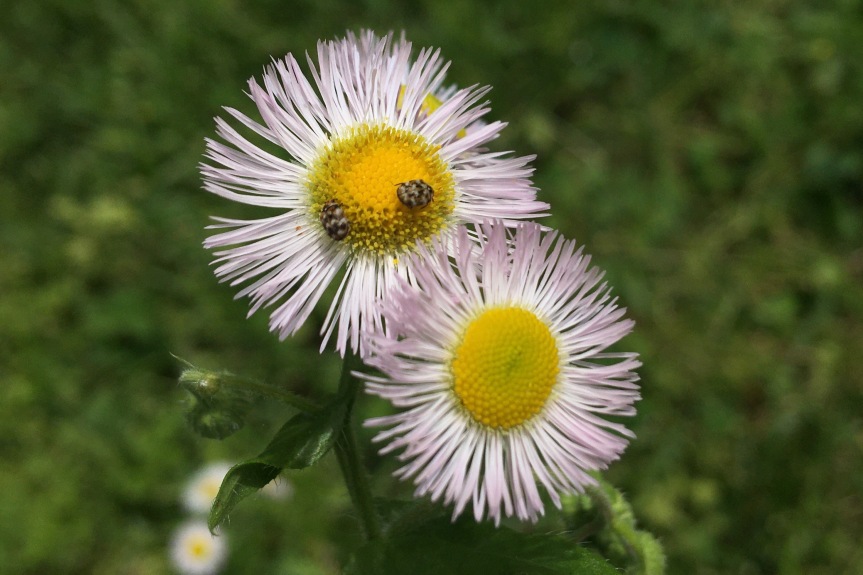My friend Taunia forwarded a question from her local listserve. It was a native plant question, so of course I dropped everything to answer right that minute. Laundry could wait. As could paperwork and four-lined plant bugs and the oodles of other Shelter-in-Place tasks that had already broken me for the day. What a relief to sit for a few moments and to focus, quietly, on . . . fleabane.
“I’ve noticed many yards are avoiding mowing what I think is fleabane. Is this a desirable native? I’ve been pulling it up since I didn’t plant it, but should I let it stay?
My really, real answer is that ANY native is more desirable than the exotics in most yards. Natives feed animals. Natives contribute to the ecosystem.

But here’s my actual reply:
Right now in Nashville, native fleabanes are showing up in yards. All are beneficial to our foodweb: nectar and pollen and leaves feed hungry invertebrates; who might then feed hungry birds (migration is in full swing, and our local breeding birds need food, too).
If you sit next to a patch to fleabane, you’ll see non-stop action: various bees (from sweat bees to cute lil’ mining bees to honeybees), skippers and butterflies, flies of all sizes, tiny flower beetles, ants, and if you get really close: thrips. You’ll see insect predators like crab spiders (they can turn yellow or white to match a flower), assassin bugs, predatory wasps, ladybug larvae, lacewing larvae, and so on.
You will never be bored while staring at native flowers.

I let fleabane bloom and seed at will. It makes islands of “meadow” in the yard, without any effort from me.
What is more delightful than beauty without toil?
I’ll tell you what: beauty that can feed multitudes.
Occasionally, I do throw a fluffy, seedy fleabane onto an area where I want more meadow next year.

The two species in my yard are:
1) Philadelphia fleabane / Erigeron philadelphicus. This began blooming a few weeks ago and hasn’t finished yet. Sometimes the white is tinged with pink and quite lovely. The leaves are distinctive: they “clasp” the stem as if they are folded around it. It is an annual plant and will seed itself far and wide, so you likely see it again next spring.
2) Annual fleabane / Erigeron annuus. Annual fleabane is just starting to bloom. It typically starts weeks after Philadelphia. Flowers are similar but the leaves are not clasping, and are a bit wider, more rounded. It, too, is an annual, but I’ve noticed the flowers seem to bloom longer and look less weedy, more garden-y.
Another common species is Daisy fleabane / Erigeron strigosus.
Squint and you probably can’t tell any of them apart, but all are useful.

Bottom Line:
Any native plant is many, many times more functional than an exotic plant in the same space, so when I see a native plant that has managed to eke out existence in our exotic turfgrass lawns (with exotic monkey grass and exotic shrubs galore), I let it do it’s thing. Native plants have co-evolved with native animals—from invertebrates on up—and we need all of them to keep our world working.
Remember: insects and other invertebrates are bird food. Many birds who come to our feeders cannot feed their babies seed. They need meat. A chickadee parent needs 400 caterpillars per day to raise a family (Audubon link).

For more info about these fleabanes, see the excellent website IllinoisWildflowers.info. Plant portraits always include “Faunal Associations:” a list of animals who interact with and rely on the plant as food.
(Links: Philadelphia fleabane and Annual fleabane and Daisy fleabane.)

About the author:
My Instagram posts are 100% nature, and most of it the Sidewalk kind.
No shots of my teacup unless there is a plant or animal floating in it.
I’m not fond of facebook, but some people are on it who aren’t on Instagram, so I post nature things there from time to time.
Bio:
Joanna Brichetto is a naturalist in Nashville, the hackberry-tree capital of the world.
She writes about everyday natural wonders amid every habitat loss, and her essays have appeared in Brevity, Fourth Genre, Hippocampus, The Hopper, Flyway, The Common, City Creatures, The Fourth River and other journals.
Her current project is a book of linked essays called Paradise in a Parking Lot.

What an interesting post, Fleabane here is yellow!
Yours must be the famous fleabane used to repel fleas, yes? Pulicaria dysenterica: native to Europe, and when crushed, has the smell of what one site described as “chrysanthemum mixed with camphor”? I’ve just read it is a perennial and can bloom from summer through fall.
I love my fleabane! Because of you, and your excellent posts, I have delayed mowing, stopped mowing the buttercups and fleabane, etc., and have joined INaturalist. You’re so wonderful to teach us about the world we live in, especially now! We need all the beauty we can get…
So thrilled you’ll be posting your observations! We do need all the beauty we can get, and our watersheds need all the native plants they can get: every leaf, bloom, seed, root will be put to good use!
Thanks for helping me identify this! I liked it when I appeared out of nowhere in my garden. Now I know the name and know for sure to keep it. Appreciate you.
Great! Thanks for letting me know!